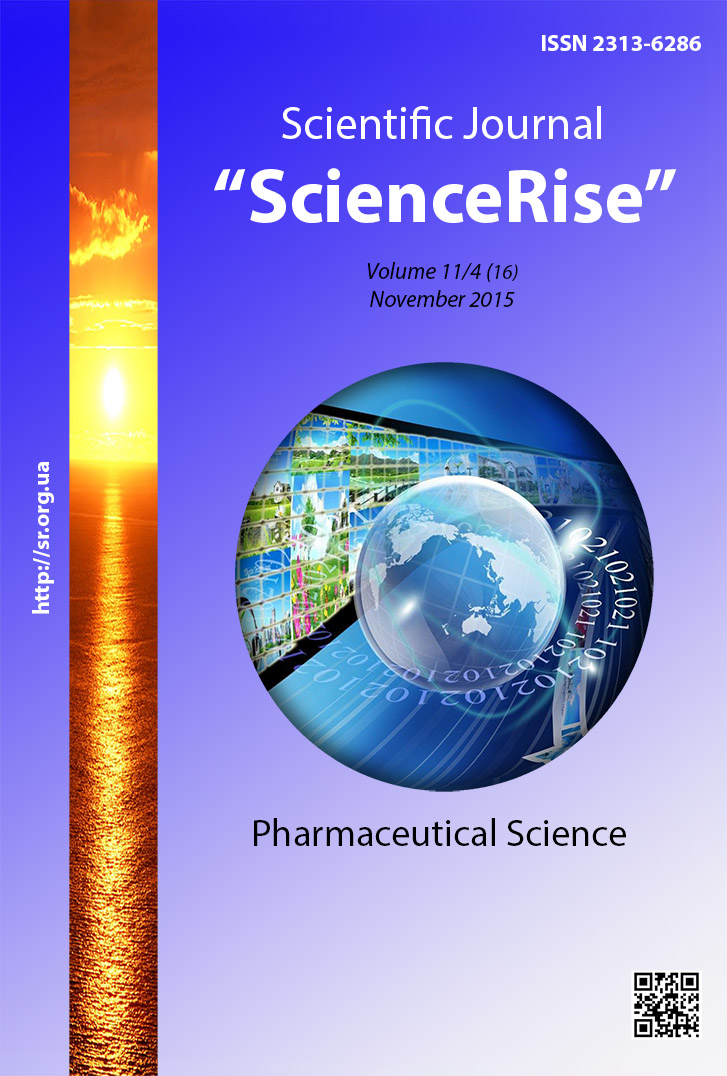Анализ и пути расширения ассортимента экстемпоральных лекарственных средств в республике Таджикистан
DOI:
https://doi.org/10.15587/2313-8416.2015.54991Ключові слова:
экстемпоральные лекарственные средства, анализ рецептуры, производственные аптеки, лекарственные формыАнотація
За последнее двадцатилетие в странах бывшего СССР наблюдалась тенденция уменьшения объема приготовления экстемпоральных лекарственных средств, многие субъекты хозяйствования отказались от осуществления данного вида деятельности из-за ряда нормативных и экономических причин. В то же время в Республике Таджикистан существует необходимость обеспечения населения индивидуальными лекарственными средствами, которые не имеют промышленных аналогов.
Цель. Целью данной работы является анализ рецептуры производственных аптек Республики Таджикистан, поиск путей расширения номенклатуры экстемпоральных лекарственных средств.
Методы. Для решения поставленной цели были использованы общепринятые аналитические исследования источников литературы и номенклатуры экстемпоральных лекарственных средств, методы синтеза и обобщение данных.
Результаты. Был проведен анализ рецептуры производственных аптек Таджикистана согласно данным, полученным от Государственной инспекции Республики Таджикистан за 2012 год. Ассортимент экстемпоральных лекарственных средств представлен глазными и ушными каплями, каплями для носа, порошками, мазями, растворами для наружного и внутреннего применения, лекарственными средствами для парентерального применения.
Выводы. В результате анализа рецептуры производственных аптек Республики Таджикистан подтверждена необходимость ее пересмотра, обновления, актуальным является разработка новой рецептуры и введение в состав современных, более эффективных активных фармацевтических ингредиентов. Перспективным является разработка рецептуры экстемпоральных лекарственных средств для оказания паллиативной помощи, заместительной гормональной терапии, медикаментозной помощи спортсменам, для применения в педиатрии, гериатрии, ветеринарии, стоматологии, дерматологии
Посилання
Vlasenko, I. O. (2008). Ekstemporal'ne vygotovlennja – vizytna kartka klasychnoi' apteky. Farmacevt-praktyk, 5, 60–62.
Egorova, S. N., Nevolina, E. V. (2013). Aptechnoe izgotovlenie lekarstvennyh form: problemy, trebujushhie pravovogo reshenija. Vestnik Roszdravnadzora, 6, 36–38.
Sjatynja, M. L., Popovych, V. P., Glushhenko O. M. et. al. (2011). Indyvidual'ne vygotovlennja likiv v aptekah. Farmacevtychnyj chasopys, 4, 90–95.
Carvalho, M., Tuleu, C., Taylor, K. (2008). Current Compounding Practices in Europe. International Journal of Pharmaceutical Compounding, 2, 94-99.
Vail, J., Naddeo, A. M., Kinget, R. et. al. (2008). Compounding Around the World. International Journal of Pharmaceutical Compounding, 2, 102–115.
Kolesnik, M. (2007). Jekstemporal'naja receptura: realii i perspektivy. Provizor, 19, 57–60.
Kolesnik, M. (2007). Jekstemporal'noe proizvodstvo: byt' ili ne byt'? Provizor, 3, 8–12.
Kosjachenko, K. L., Nemchenko, A. S. (2011). Analiz suchasnyh organizacijno-ekonomichnyh problem vygotovlennja likars'kyh zasobiv v umovah apteky. Upravlinnja, ekonomika ta zabezpechennja jakosti v farmacii', 2 (16), 34–39.
Krasnjuk, I. I., Sboev, G. A. (2006). Problemy garmonizacii aptechnoj praktiki s mezhdunarodnoj sistemoj farmacevticheskoj pomoshhi. Remedium, 8, 38–40.
Kryvov’jaz, O. V., Golod, A. S. (2011). "Personal'ni liky" jak racional'nyj shljah vidrodzhennja ekstemporal'noi' receptury v Ukrai'ni. Aktual'ni pytannja farmacevtychnoi' i medychnoi' nauky ta praktyky, 24 (2), 81–83.
Ponomareva, E. A., Tjurenkov, I. N. (2010). Realii aptechnogo izgotovlenija lekarstvennyh sredstv. Remedium, 11, 47–48.
PIC/S Guide to good practices for the preparation of medicinal products in healthcare establishments. PE 010-3, 1 October 2008. Available at: http://www.picscheme.org/
A guide for compounding practitioner USP 35 - NF 30 / The United States Pharmacopeial Convention (2012). Rockville, 317.
Jevtifjejeva, O. A. (2013). Analitychnyj ogljad systemy zabezpechennja jakosti ekstemporal'nyh likars'kyh zasobiv u rozvynutyh krai'nah svitu. Visnyk farmacii', 1, 9–18.
Sabirzhan, R. R. (2012). Aptechnoe izgotovlenie lekarstvennyh form dlja lechebno-profilakticheskih uchrezhdenij: izuchenie sovremennoj nomenklatury. Nauchnye vedomosti BelGU. Serija: Medicina. Farmacija, 10-2 (129), 31–35.
Tihonov, A. I. (Ed.) (1999). Spravochnik jekstemporal'noj receptury. Kyiv: MORION, 496.
Foppe vann Mil, Dzh. V., Dzh. Mak Elni, T. F. (2001). Obshhestvennaja farmacija v mire. Farmac. zhurn., 6, 27–32.
World Health Organization official website. Available at: http://www.who.int/en/
Schotik, D. (2001). Stability Issues for Compounding Extemporaneously Prepared Oral Formulations for Pediatric Patients. Int J Pharm Compd., 1, 9.
Zdoryk, O. A. (2013). Svitovyj dosvid vyznachennja terminu prydatnosti likars'kyh zasobiv aptechnogo vygotovlennja. Farmac. zhurn., 6, 42–47.
##submission.downloads##
Опубліковано
Номер
Розділ
Ліцензія
Авторське право (c) 2015 Абдуджаббор Халкуллоевич Валиев, Александр Анатольевич Здорик

Ця робота ліцензується відповідно до Creative Commons Attribution 4.0 International License.
Наше видання використовує положення про авторські права Creative Commons CC BY для журналів відкритого доступу.
Автори, які публікуються у цьому журналі, погоджуються з наступними умовами:
1. Автори залишають за собою право на авторство своєї роботи та передають журналу право першої публікації цієї роботи на умовах ліцензії Creative Commons CC BY, котра дозволяє іншим особам вільно розповсюджувати опубліковану роботу з обов'язковим посиланням на авторів оригінальної роботи та першу публікацію роботи у цьому журналі.
2. Автори мають право укладати самостійні додаткові угоди щодо неексклюзивного розповсюдження роботи у тому вигляді, в якому вона була опублікована цим журналом (наприклад, розміщувати роботу в електронному сховищі установи або публікувати у складі монографії), за умови збереження посилання на першу публікацію роботи у цьому журналі.

